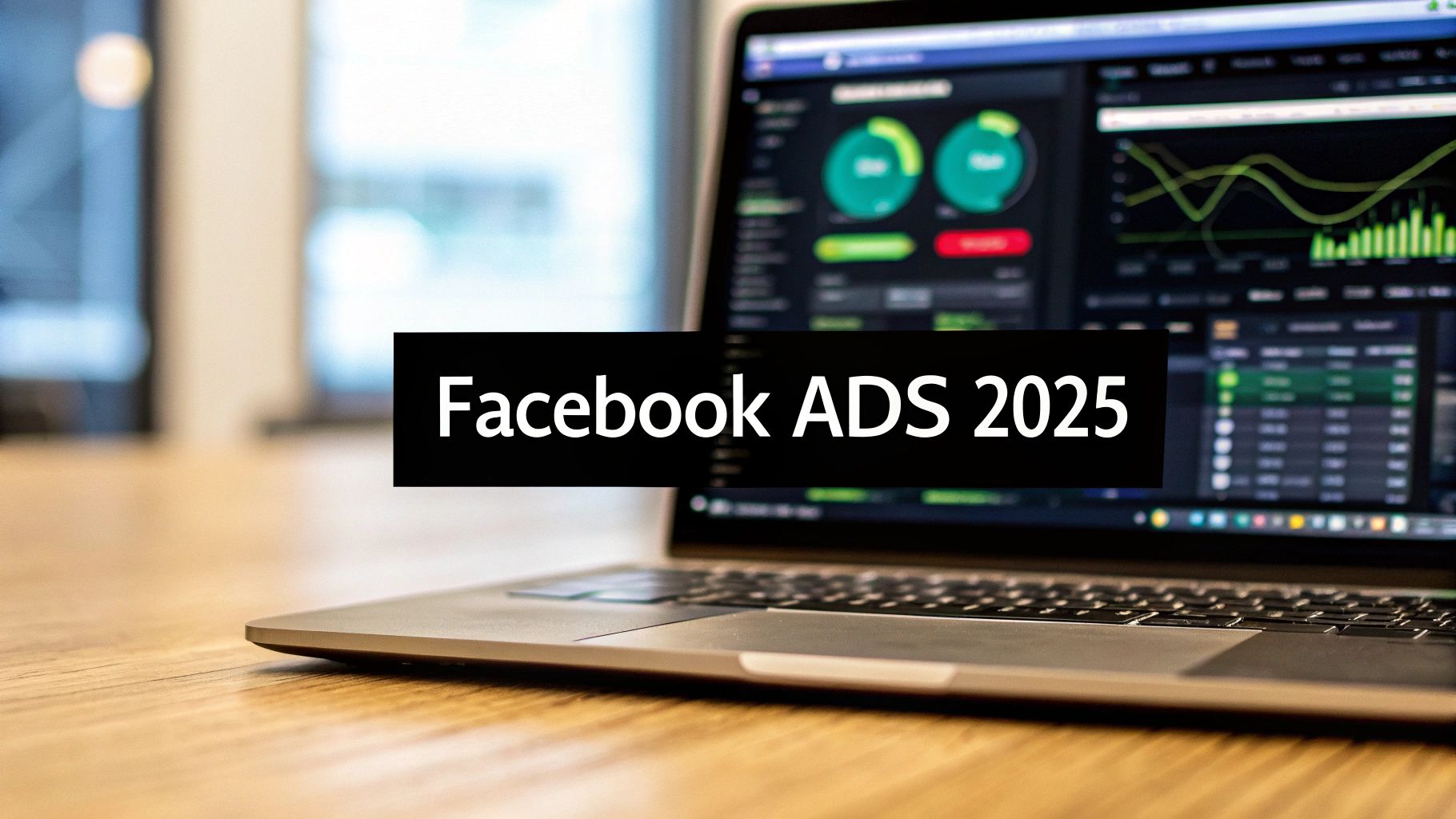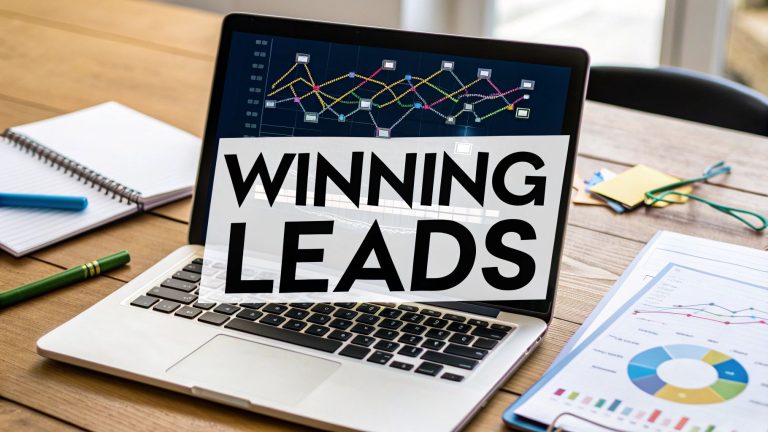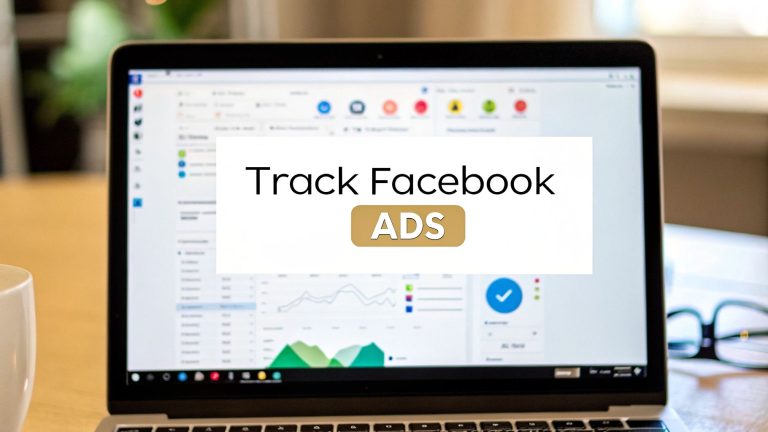7 Facebook Advertising Best Practices for 2025 Success
Unlocking Facebook Ads Success in 2025
Maximize your Facebook advertising ROI with these seven essential best practices. This listicle provides actionable strategies to refine your campaigns, boost conversions, and control costs. Learn how to define laser-focused target audiences, leverage video and Stories, optimize for mobile, and implement effective retargeting. We'll cover A/B testing, Facebook Pixel integration, and budget optimization for maximum impact. Whether you’re a small business, agency, or marketing professional, these Facebook advertising best practices will help you achieve your 2025 goals.
1. Define Clear Target Audiences with Custom and Lookalike Audiences
One of the most crucial Facebook advertising best practices is defining clear target audiences. This involves moving beyond basic demographic targeting and leveraging Facebook's advanced audience creation tools to reach the most receptive users. By creating highly specific audience segments using Custom and Lookalike Audiences, you can deliver personalized messaging that resonates, leading to higher conversion rates and a better return on ad spend (ROAS). This targeted approach ensures your ads are seen by the right people, minimizing wasted ad spend and maximizing impact. Instead of casting a wide net and hoping for the best, you're focusing your efforts on individuals most likely to be interested in your product or service.
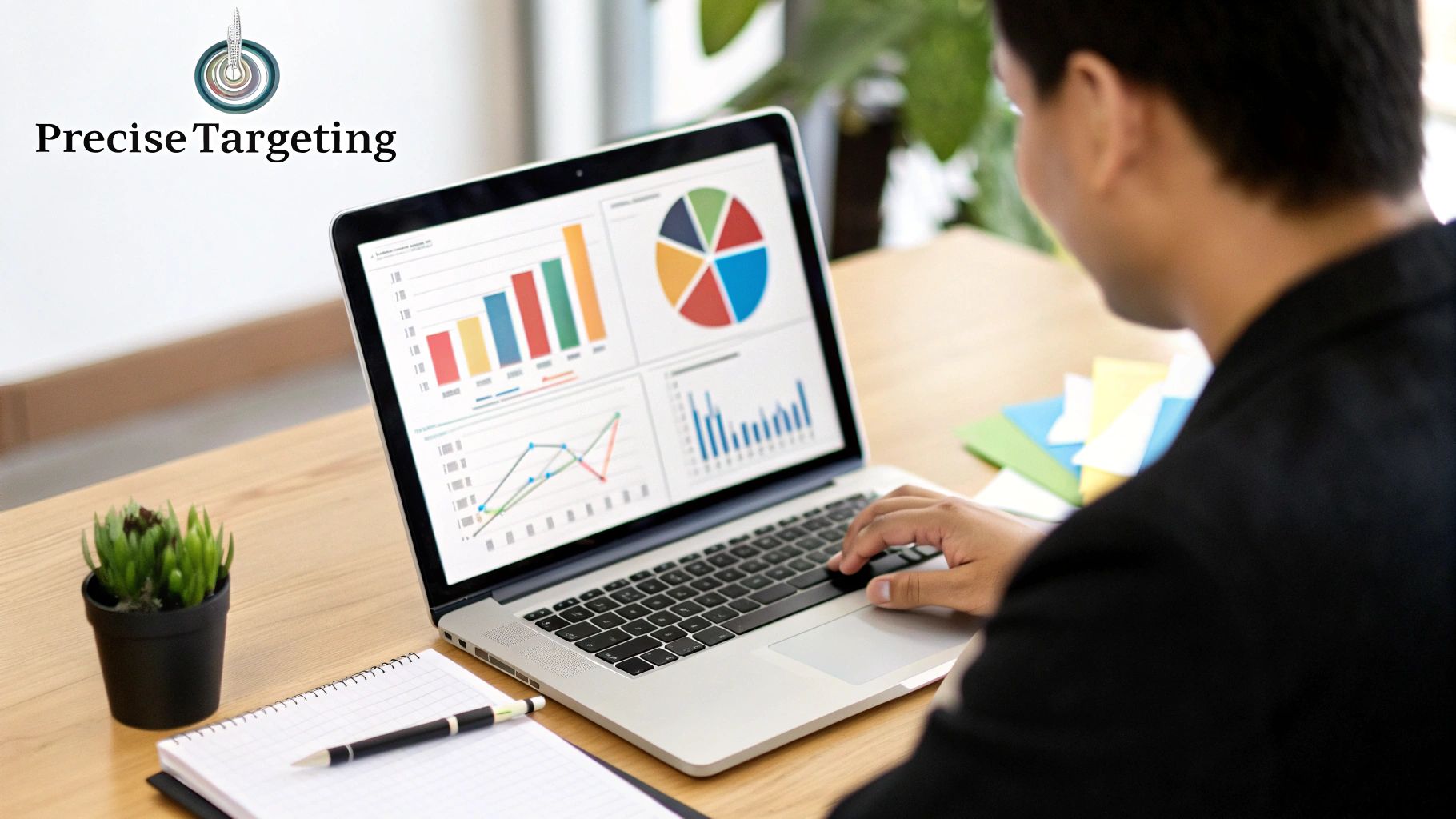
Custom Audiences allow you to target existing customers or prospects who have already interacted with your business. You can upload customer lists (emails, phone numbers), target website visitors using the Facebook Pixel, engage app users, or even target people who have interacted with your content on Facebook or Instagram. Lookalike Audiences, on the other hand, take this a step further. Facebook analyzes your existing Custom Audience (e.g., your top customers) and finds users with similar characteristics, effectively expanding your reach to a new pool of potential customers who resemble your best-performing segments.
This practice deserves its place in the list of Facebook advertising best practices because it's fundamental to achieving optimal campaign performance. By targeting specific user groups, you significantly increase the relevance of your ads, resulting in higher click-through rates, conversions, and ultimately, a better ROI. You're not just showing ads; you're delivering personalized messages to individuals who have already demonstrated an interest in your brand or share characteristics with your ideal customer profile. For more details, you can learn more about Define Clear Target Audiences with Custom and Lookalike Audiences.
The benefits are numerous. Higher conversion rates are a direct result of delivering relevant messaging. Imagine showing an ad for a specific product category to someone who has already browsed that category on your website. The chances of conversion are significantly higher than showing a generic ad to a broad audience. Improved relevance scores also translate to lower cost per acquisition, as Facebook rewards advertisers who create highly targeted campaigns. Furthermore, by showing ads only to interested users, you reduce ad fatigue, preventing potential customers from becoming annoyed or tuning out your message.
However, there are some challenges to consider. Creating effective Lookalike Audiences requires sufficient data in your initial Custom Audience. A small Custom Audience may not provide Facebook enough information to generate a high-quality Lookalike Audience. Additionally, while narrow targeting is effective, it can limit reach and scale. Managing multiple audience segments can also be time-consuming, and the iOS 14.5+ privacy changes have impacted targeting precision, making accurate audience definition more challenging.
Successful businesses leverage Custom and Lookalike Audiences to drive significant results. For example, Airbnb uses Lookalike Audiences based on their highest-value hosts to find new property owners. Shopify creates Custom Audiences from abandoned cart visitors for retargeting campaigns, reminding potential customers of items they left behind and encouraging them to complete their purchase. Netflix targets Lookalike Audiences based on users who completed free trials, aiming to acquire new subscribers who share similar viewing habits.
Here are some actionable tips to help you implement this Facebook advertising best practice:
- Start with Custom Audiences: Build solid Custom Audiences from your existing customer data before creating Lookalike Audiences. This ensures a strong foundation for accurate targeting.
- Test Lookalike Percentages: Experiment with different Lookalike Audience percentages (1-10%). Smaller percentages (1-3%) yield higher quality audiences, while larger percentages (4-10%) offer greater reach.
- Exclude Existing Customers: When targeting acquisition campaigns, exclude existing customers to avoid showing ads to people who have already converted.
- Refresh Audience Lists: Regularly update your Custom Audience lists to maintain accuracy and ensure you're targeting the most current data.
- Test and Refine: Start with broader targeting during the testing phase, then narrow down your audiences based on performance data to optimize your campaigns over time.
By understanding and implementing these strategies, you can significantly improve the performance of your Facebook advertising campaigns and achieve your marketing objectives more effectively.
2. A/B Test Creative Elements Systematically
One of the most impactful Facebook advertising best practices is systematically A/B testing your creative elements. This involves running controlled experiments where you compare different versions of your ad creatives—images, videos, headlines, ad copy, and calls-to-action—to determine which resonates most effectively with your target audience. Instead of relying on guesswork or intuition, systematic A/B testing empowers you to make data-driven decisions, optimizing your campaigns for maximum performance and return on investment. This process hinges on changing only one variable at a time to isolate its impact and using statistical significance to validate the results. By meticulously analyzing the performance of different variations, you can pinpoint the elements that drive higher click-through rates, conversions, and ultimately, business growth.

Facebook provides built-in A/B testing tools directly within its Ads Manager, making it easy to set up and manage these experiments. You can split test virtually every aspect of your ad creative, from the visuals (images and videos) to the text elements (headlines, body copy, and call-to-action buttons). The platform also provides statistical significance indicators, helping you understand whether the performance differences between variations are genuine or simply due to random chance. Performance metrics are tracked across all variants, giving you a clear picture of how each element performs. Furthermore, Facebook can automatically allocate a larger portion of your budget to the winning variations, further maximizing your ROI.
This approach offers significant advantages. Data-driven optimization, fueled by A/B testing insights, consistently leads to improved ad performance over time. It eliminates the guesswork often associated with creative decisions, allowing you to focus on strategies proven to work. Consistent testing facilitates continuous improvement in key metrics like click-through and conversion rates. Perhaps most importantly, it provides a deeper understanding of audience preferences, enabling you to tailor your messaging and creative elements to resonate more effectively with your target demographic.
However, A/B testing isn't without its drawbacks. It requires a sufficient budget and traffic volume to achieve statistical significance. Meaningful results require a large enough sample size, which can translate to higher ad spend. It's also a time-intensive process that demands patience. You need to allow sufficient time for the tests to run and gather enough data. This can slow down the initial campaign launch while you're waiting for conclusive results. Finally, it's important to remember that results from one test may not always be transferable across different audiences. What works for one segment may not necessarily resonate with another.
Numerous successful implementations highlight the power of A/B testing. HubSpot, for instance, increased conversions by a remarkable 106% simply by testing different CTA button colors and text. Unbounce improved click-through rates by 90% through systematic headline testing. AdEspresso (now part of Hootsuite) regularly shares case studies showcasing creative tests that have boosted ad performance by 200-400%. These examples demonstrate the significant impact that even seemingly small changes can have when informed by data-driven testing.
To effectively implement A/B testing in your Facebook ad campaigns, consider these actionable tips:
- Test one element at a time: Isolating variables provides clear insights into the impact of each change.
- Run tests for at least 7-14 days: Account for daily variations in user behavior and gather sufficient data.
- Ensure adequate sample sizes: Larger sample sizes increase the reliability and statistical significance of your results.
- Document your results: Build a knowledge base for future campaigns, learning from both successes and failures.
- Explore different creative approaches: Test emotional vs. rational appeals, various value propositions, and diverse visual styles.
A/B testing is crucial for anyone managing Facebook ad campaigns, from small businesses and startups to large enterprises and marketing agencies. By embracing a systematic approach to testing, you can optimize your campaigns for maximum effectiveness, achieving higher ROI and a deeper understanding of your audience. This practice, popularized by growth marketing teams at Facebook and conversion optimization experts like Peep Laja, is a cornerstone of successful Facebook advertising.
3. Implement Facebook Pixel and Conversion API for Comprehensive Tracking
In the ever-evolving landscape of digital advertising, accurate tracking is paramount. For businesses leveraging Facebook Ads, implementing both the Facebook Pixel and Conversion API is no longer a best practice, but a necessity for comprehensive tracking and optimized campaign performance. This powerful combination creates a robust measurement system, providing valuable insights into user behavior, campaign effectiveness, and audience building, all while mitigating data loss from increasing browser restrictions and ad blockers. This approach is crucial for any business serious about maximizing their return on ad spend (ROAS) and achieving their marketing objectives on Facebook.
The Facebook Pixel is a snippet of code placed on your website that tracks visitor actions. Think of it as a digital detective, observing user behavior such as page views, product additions to cart, and purchases. This data feeds back into Facebook Ads Manager, allowing you to understand how users interact with your website after clicking on your ads. This information is then used to optimize your campaigns, create custom audiences based on website activity, and measure the effectiveness of your advertising efforts.
The Conversions API (formerly known as Server-Side API) complements the Pixel by sending web event data directly from your server to Facebook. This server-side tracking provides a critical layer of redundancy, ensuring data capture even when browser-based tracking is blocked by ad blockers or privacy settings like those introduced with iOS 14.5+. This dual approach allows for more accurate attribution and a more complete picture of the customer journey.
Features and Benefits:
- Website Visitor Tracking and Behavior Analysis: Understand how users navigate your site, identify popular products or content, and pinpoint areas for improvement in user experience.
- Custom Conversion Event Setup: Track specific actions valuable to your business, such as purchases, form submissions, lead magnet downloads, or even phone calls.
- Server-Side Tracking through Conversions API: Maintain accurate tracking despite browser restrictions, ensuring reliable data for optimization and attribution.
- Cross-Device and Cross-Platform Attribution: Follow user journeys across devices and platforms, gaining a holistic view of campaign performance.
- Audience Building from Website Interactions: Create highly targeted custom audiences based on specific website behaviors, enabling personalized retargeting campaigns.
Pros:
- Accurate ROI Measurement and Campaign Attribution: Understand which ads are driving conversions and optimize spending accordingly.
- Better Audience Targeting Through Behavioral Data: Refine targeting based on actual website activity for improved ad relevance and engagement.
- Improved Ad Delivery Optimization: Facebook's algorithm can leverage comprehensive data to deliver ads to the most receptive audiences.
- Resilience Against iOS 14.5+ Privacy Changes Through Server-Side Tracking: Maintain tracking accuracy and campaign effectiveness despite increasing privacy restrictions.
Cons:
- Technical Implementation Complexity: Setting up both Pixel and Conversions API can be technically challenging, requiring development resources or specialized plugins.
- Privacy Concerns and Compliance Requirements (GDPR, CCPA): Ensure compliance with data privacy regulations by implementing proper consent mechanisms and data handling practices.
- Potential Data Discrepancies Between Platforms: Occasional discrepancies between Pixel and Conversions API data may require troubleshooting and reconciliation.
- Requires Ongoing Maintenance and Updates: Keeping the implementation up-to-date with Facebook's changes is essential for continued accuracy and functionality.
Examples of Successful Implementation:
- Shopify merchants utilize Pixel tracking to trigger dynamic retargeting campaigns for abandoned carts, reminding potential customers to complete their purchases.
- SaaS companies like Zoom track trial sign-ups and conversions to paid plans using both Pixel and Conversions API, gaining insights into the effectiveness of their marketing funnel.
- E-commerce brands leverage Conversions API to maintain tracking accuracy despite browser restrictions, ensuring reliable data for optimizing their product campaigns.
Actionable Tips:
- Implement Both Pixel and Conversions API for Maximum Data Coverage: Combining both provides a robust and resilient tracking system.
- Set Up Custom Events that Align with Your Business Objectives: Track the actions most important to your business goals, whether it's lead generation, purchases, or newsletter sign-ups.
- Use Google Tag Manager for Easier Pixel Management: Simplify pixel implementation and management with a tag management system like Google Tag Manager.
- Test Pixel Functionality Regularly Using Facebook's Pixel Helper Tool: Ensure your pixel is firing correctly and capturing the intended data.
- Ensure Compliance with Privacy Regulations by Implementing Proper Consent Mechanisms: Prioritize user privacy by obtaining consent for data collection and usage.
By implementing both the Facebook Pixel and Conversions API, businesses gain a significant advantage in the competitive world of Facebook advertising. This comprehensive tracking approach enables data-driven decision-making, optimized campaign performance, and ultimately, a higher return on investment. It’s a crucial best practice for any business looking to leverage the full power of Facebook Ads.
4. Leverage Video Content and Stories Format
In today's dynamic digital landscape, grabbing the attention of your target audience on Facebook requires more than just static images and text. Leveraging video content and the Stories format has become a cornerstone of successful Facebook advertising best practices. This approach capitalizes on the increasing preference for video consumption on social media, offering a more engaging and immersive experience for users. It involves understanding how different video formats work on Facebook, optimizing video length for each placement, and utilizing the full-screen, vertical nature of Stories to create a connection with your audience.
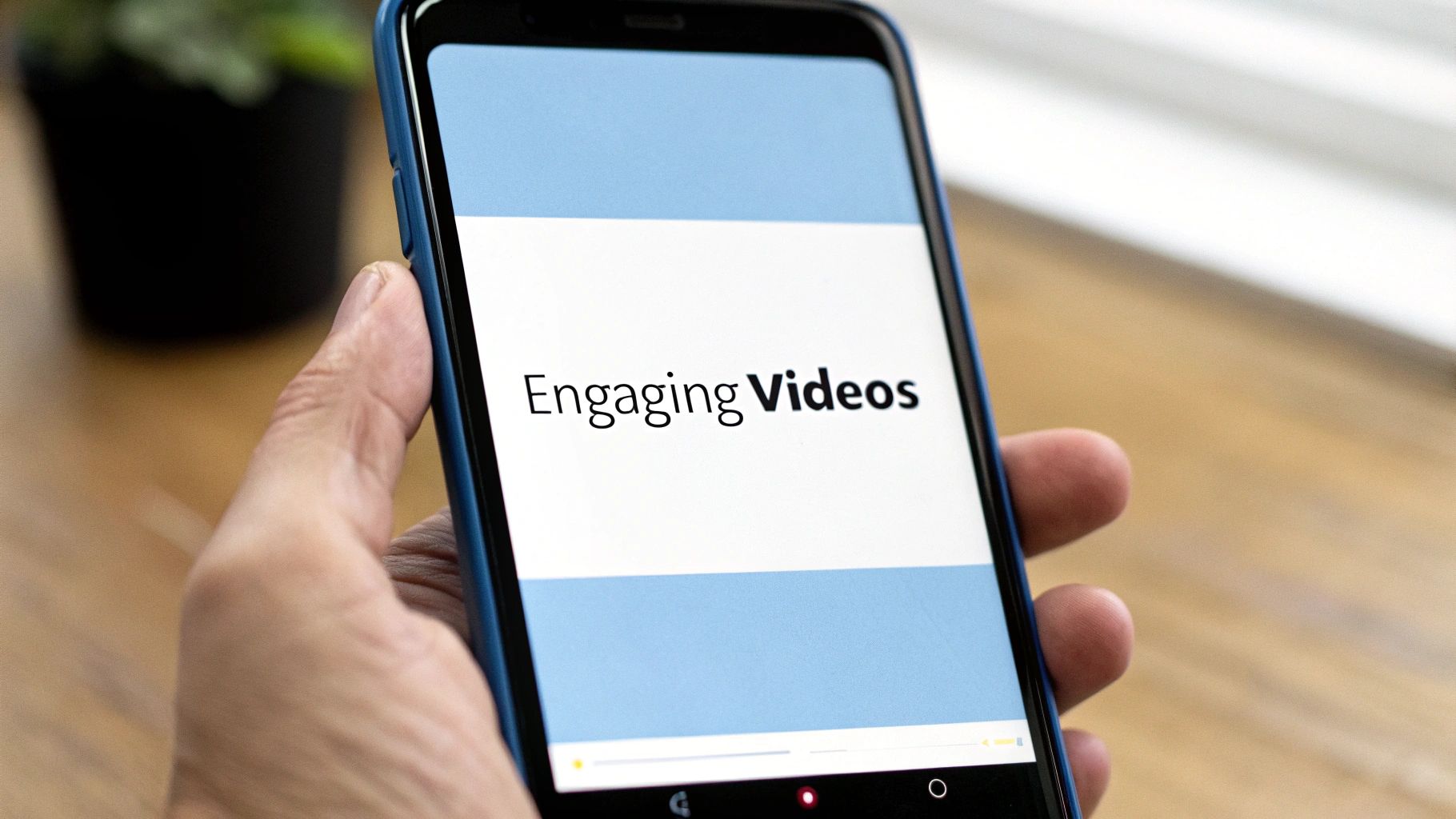
Facebook offers a variety of video ad formats to cater to different marketing objectives. These include in-feed videos that appear within the user's newsfeed, Stories ads that play between organic Stories, Reels ads that leverage the short-form video trend, and in-stream ads that play during longer video content. Each format has its own specifications and best practices. For example, in-feed videos can be longer and more detailed, while Stories ads should be short, snappy, and visually captivating to maintain viewer interest. The auto-play functionality, often with sound off by default, requires optimizing videos for silent viewing through the use of captions and engaging visuals. Stories also offer interactive elements like polls and swipe-up actions, enhancing audience participation and driving traffic to your website or landing page. Finally, the platform supports vertical, square, and horizontal video options, allowing flexibility in repurposing existing content or creating bespoke ads for each placement. Facebook also provides built-in editing tools and templates to simplify the video creation process, making it accessible even for businesses with limited resources.
The benefits of incorporating video and Stories into your Facebook advertising strategy are numerous. Video content consistently achieves higher engagement rates compared to static images, as the dynamic visuals and storytelling capabilities capture attention more effectively. This is particularly true for complex products or services where video can demonstrate functionality and value proposition more clearly. Moreover, video ads, especially those within Stories, provide access to younger demographics who overwhelmingly prefer video content to other formats. Stories ads, in particular, feel more native and less intrusive than traditional banner ads, integrating seamlessly into the user's browsing experience.
Several brands have demonstrated the effectiveness of video and Stories advertising on Facebook. Nike, for instance, has seen tremendous success with Stories campaigns featuring athletes, achieving 3x higher engagement rates compared to their static image posts. Dollar Shave Club, a subscription-based grooming company, has leveraged humorous and informative video ads to generate a 40% lower cost per acquisition than their image-based campaigns. Similarly, Tasty, known for its short, engaging recipe videos, averages over 100 million views per video, driving significant traffic to their website and building a strong brand community.
While the advantages are clear, video advertising on Facebook also presents some challenges. Higher production costs and the time investment required for video creation can be a barrier, especially for smaller businesses. Developing distinct content strategies for each video format – in-feed, Stories, Reels – can also be complex. Additionally, video file size limitations and technical requirements can pose hurdles. Finally, the short attention spans of users, particularly on platforms like Stories, necessitate compelling opening seconds to hook viewers and prevent them from skipping your ad.
To maximize the impact of your Facebook video and Stories ads, consider these actionable tips: Hook viewers within the first 3 seconds with captivating visuals or thought-provoking questions. Design your videos to be effective without sound by incorporating captions and relying on visual storytelling. Keep your Stories ads concise, ideally under 15 seconds, to maintain optimal completion rates. Utilize vertical video (9:16 aspect ratio) for a mobile-optimized viewing experience, aligning with the native format of Stories and Reels. Finally, ensure you include clear calls-to-action and prominent brand elements early in the video to reinforce your message and drive desired actions.
Leveraging video content and the Stories format is no longer optional for businesses seeking to thrive on Facebook. Its place within the best practices for Facebook advertising is solidified by its ability to capture attention, drive engagement, and ultimately achieve marketing objectives in a video-first world. By understanding the nuances of each format and applying the outlined tips, you can harness the power of video to connect with your target audience and achieve tangible results.
5. Optimize for Mobile-First Experience
In the realm of Facebook advertising best practices, prioritizing a mobile-first experience isn't just recommended—it's essential. With over 90% of Facebook users accessing the platform through mobile devices, your ads need to be designed specifically for these smaller screens. Simply adapting desktop content won't cut it. A true mobile-first approach requires a fundamental shift in thinking, focusing on creating thumb-stopping visuals, lightning-fast mobile landing pages, and a seamless mobile user journey throughout the entire conversion funnel. This is critical for any business implementing successful Facebook advertising best practices.
This practice recognizes the reality of how people interact with Facebook. They're scrolling through their feeds on their phones, often in short bursts, and your ads need to grab their attention immediately. This means utilizing mobile-specific ad placements and formats, adhering to thumb-stopping creative design principles, and ensuring your landing pages are optimized for speed and mobile navigation. A clunky desktop experience ported to mobile will lead to high bounce rates, lost conversions, and a wasted advertising budget.
Several key features contribute to a successful mobile-first Facebook ad campaign. These include mobile-specific ad placements like Instagram Stories and in-stream video ads, eye-catching visuals designed with mobile consumption in mind, landing pages that load quickly on mobile connections, touch-friendly interface elements that are easy to interact with on a smaller screen, and mobile-optimized checkout processes that minimize friction for mobile users.
The benefits of adopting a mobile-first approach are numerous. A better user experience translates directly into higher conversion rates. When users can easily navigate your ads and landing pages on their mobile devices, they are more likely to complete the desired action, whether it’s making a purchase, signing up for a newsletter, or downloading an app. Lower bounce rates from mobile-optimized pages also contribute to improved quality scores and lower ad costs, making your campaigns more efficient. Furthermore, focusing on mobile opens up access to mobile-specific ad placements and features, expanding your reach and targeting options.
However, optimizing for mobile does come with its own set of challenges. It requires dedicated mobile optimization efforts, meaning you can’t simply repurpose desktop content. The limited screen real estate on mobile devices necessitates concise messaging and strategic use of visuals. The need for faster loading times increases technical requirements, demanding optimized images, streamlined code, and efficient hosting. Finally, different user behavior patterns on mobile require adjusted strategies. Mobile users often have shorter attention spans and are more likely to be on the go, so your ads need to be concise, impactful, and relevant to their immediate context.
Several companies have demonstrated the power of mobile-first Facebook advertising. Starbucks, for example, utilizes mobile-first campaigns to drive app downloads and in-store visits through location-based targeting. ASOS optimizes product images for mobile viewing, resulting in a reported 50% increase in click-through rates. Domino's has seen significant success with its mobile-optimized ordering process, which converts 65% better than desktop versions. These examples highlight the potential for increased engagement and conversions when businesses prioritize the mobile experience.
To effectively implement a mobile-first strategy for your Facebook ad campaigns, consider these actionable tips: Use large, bold text that's easily readable on small screens. Ensure your landing pages load in under three seconds on mobile connections. Test your ads on actual mobile devices, not just desktop previews, to get a true sense of the user experience. Use vertical or square image formats for better mobile visibility. Finally, simplify forms and checkout processes for easy thumb navigation. Remember, mobile users are often on the go, so make it as easy as possible for them to complete the desired action.
Learn more about Optimize for Mobile-First Experience for additional insights into optimizing the mobile lead capture process.
Pioneers in mobile marketing like Luke Wroblewski, along with UX designers at companies like Uber and Instagram, have championed the importance of mobile-first design. Performance marketers focused on mobile conversion optimization have further solidified the connection between mobile-first strategies and improved campaign results. By adopting these Facebook advertising best practices and prioritizing the mobile experience, businesses can significantly enhance their ad performance and reach a wider audience.
6. Create Strategic Retargeting Funnels
Retargeting is a powerful tool in Facebook advertising best practices, allowing you to re-engage users who have already interacted with your brand. However, simply showing the same ad to everyone who visited your website isn't enough. To maximize your return on ad spend and achieve higher conversion rates, you need to create strategic retargeting funnels. This practice involves building sophisticated retargeting campaigns that nurture prospects through different stages of the customer journey, from initial awareness to final purchase. It includes creating segmented audiences based on user behavior and delivering increasingly targeted messages that address specific objections and motivations at each stage.
Instead of a generic approach, retargeting funnels allow you to deliver the right message to the right person at the right time. This approach acknowledges that a first-time website visitor needs different information than someone who abandoned their shopping cart. By tailoring your ads to each stage of the funnel, you can guide potential customers towards conversion and build stronger relationships with your brand.
Features of effective retargeting funnels include multi-stage campaign sequences based on user behavior, dynamic product retargeting for e-commerce businesses, frequency capping to prevent ad fatigue, the use of exclusion audiences to prevent irrelevant targeting, and cross-platform retargeting capabilities to reach users across multiple devices and platforms.
Benefits of Retargeting Funnels:
- Higher Conversion Rates: Warm audiences, having already interacted with your brand, are more likely to convert than cold audiences.
- Improved ROI: Targeted messaging ensures your ad spend is focused on users who have shown genuine interest.
- Increased Brand Recall: Repeated exposure through retargeting keeps your brand top-of-mind.
- Recovery of Abandoned Purchases/Sign-ups: Remind users of items left in their cart or incomplete registrations, leading to recovered sales.
Challenges of Retargeting Funnels:
- Sophisticated Segmentation: Requires careful planning and analysis of user behavior to create effective segments.
- Risk of Over-Targeting: Bombarding users with too many ads can lead to negative brand perception.
- Complex Campaign Management: Managing multiple campaigns and segments requires expertise and time.
- Privacy Restrictions: Changes in privacy regulations can impact the size of your retargetable audience.
Real-World Examples:
- Amazon: Shows users products they recently viewed along with related recommendations, prompting further browsing and purchases.
- Netflix: Retargets viewers who watched trailers or specific episodes with show-specific content and subscription offers.
- Booking.com: Creates urgency by retargeting users with ads showing limited availability and price changes for previously viewed properties.
Actionable Tips for Creating Effective Retargeting Funnels:
- Segment by Engagement and Time: Group users based on their level of interaction (e.g., website visitors, product viewers, add-to-cart) and how recently they interacted.
- Tailor Messaging: Create different ad copy and visuals for each stage of the funnel. Focus on benefits and addressing potential objections.
- Use Dynamic Ads (E-commerce): Showcase the specific products users viewed, reminding them of their interest and encouraging purchase.
- Set Frequency Caps: Limit the number of times a user sees your ads within a specific timeframe to prevent ad fatigue.
- Exclude Recent Converters: Remove users who have already made a purchase from your acquisition campaigns to avoid wasting ad spend.
The following infographic illustrates a simplified 3-step retargeting funnel.
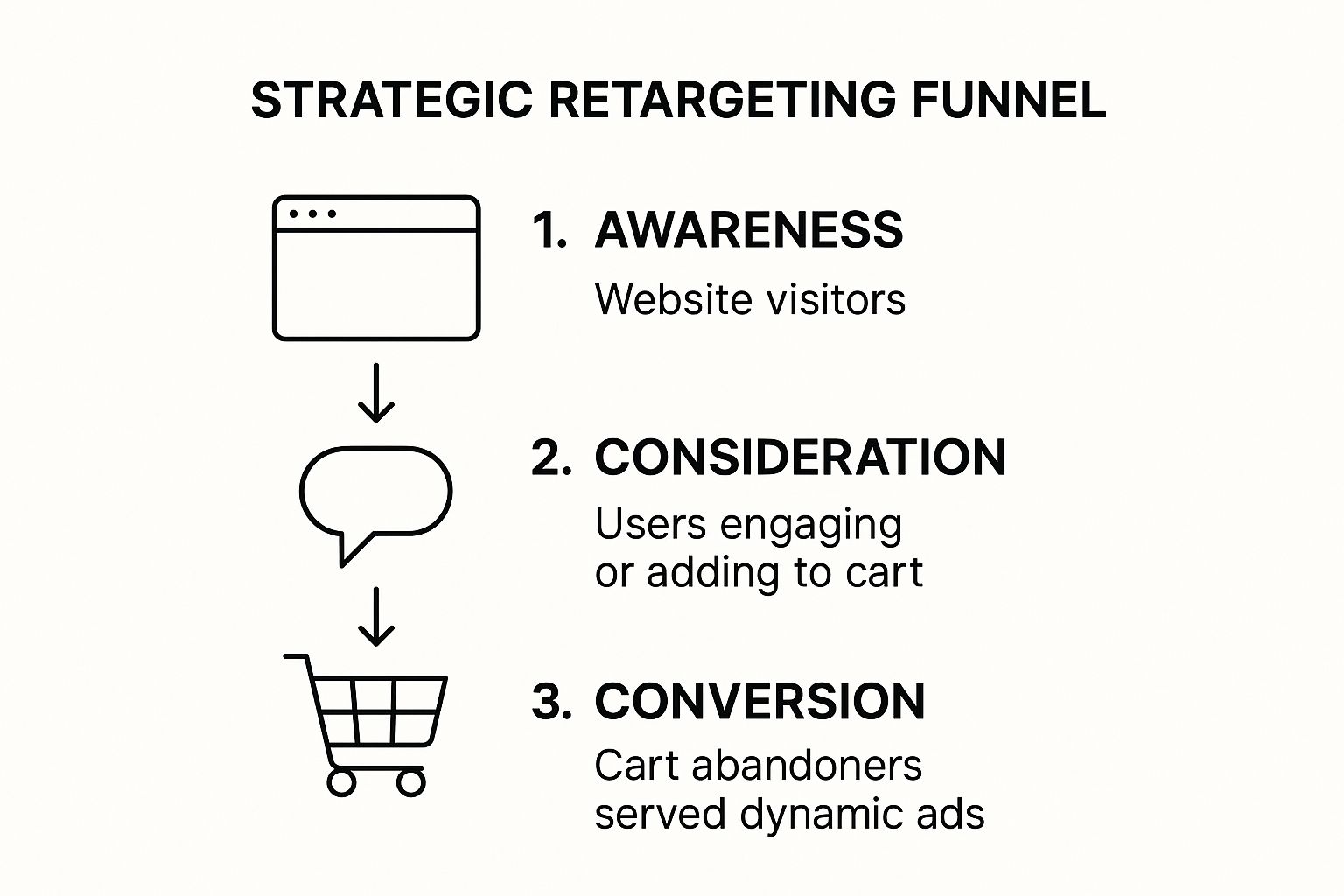
This infographic visualizes a three-stage retargeting process, starting with Awareness, moving to Consideration, and culminating in Conversion. The key takeaway from this visualization is the importance of tailoring your messaging and ad creatives to match each stage of the customer journey, ensuring relevant and impactful interactions with your target audience.
This approach, popularized by e-commerce giants like Amazon and eBay, as well as digital marketing strategists like Ryan Deiss and Perry Marshall, is crucial for any business looking to maximize the effectiveness of their Facebook advertising. By understanding the customer journey and leveraging retargeting funnels, you can significantly improve your conversion rates, increase brand recall, and drive a stronger return on your ad spend. This makes creating strategic retargeting funnels a crucial element of Facebook advertising best practices.
7. Budget Allocation and Bid Strategy Optimization
Budget Allocation and Bid Strategy Optimization is a crucial aspect of successful Facebook advertising best practices. It involves strategically distributing your advertising budget across different campaigns and ad sets while choosing the right bidding strategies to maximize your return on investment (ROI). Mastering this practice can be the difference between a profitable campaign and one that drains your resources without delivering results. This is especially critical for small and mid-sized businesses, marketing agencies, and entrepreneurs who need to make every dollar count.
This process encompasses understanding the various Facebook bid types, implementing Campaign Budget Optimization (CBO), and making data-driven budget adjustments based on performance metrics. Effectively allocating your budget and choosing the right bid strategy allows you to reach the right audience with the right message at the right price, driving conversions and achieving your campaign goals.
Facebook offers several bidding strategies, each with its own advantages and disadvantages:
-
Lowest Cost: This automated strategy aims to get you the most results for the lowest possible cost. It's a good starting point for new campaigns when you're still gathering data.
-
Cost Cap: This strategy sets a maximum cost you're willing to pay for a specific action, such as a conversion or link click. It's excellent for maintaining predictable customer acquisition costs once you have historical data and know your target cost per acquisition (CPA).
-
Bid Cap: This strategy sets a maximum bid you're willing to pay in the auction. It's particularly useful during periods of high competition to prevent your costs from spiraling out of control.
Campaign Budget Optimization (CBO) is a powerful feature that automatically distributes your budget across your ad sets within a campaign. Facebook's algorithm analyzes performance data in real-time and allocates more budget to the ad sets that are performing best. This automated optimization frees up your time and often leads to improved overall campaign performance.
Several tools and features within Facebook Ads Manager make budget allocation and bid strategy optimization more manageable:
-
Daily and Lifetime Budgets: You can set daily or lifetime budgets for your campaigns, giving you flexibility in how you control your spending.
-
Bid Adjustment Tools: These tools allow you to manually increase or decrease your bids based on factors like time of day, device, or audience demographics.
-
Automated Rules: You can set up automated rules to adjust budgets, pause campaigns, or send notifications based on specific performance triggers. This automation allows for proactive management and prevents overspending.
-
Real-Time Budget Performance Monitoring: Facebook provides detailed dashboards and reporting tools that allow you to monitor your budget performance in real-time, enabling you to identify and address any issues quickly.
Several real-world examples demonstrate the effectiveness of these strategies: Warby Parker, the popular eyewear brand, leverages cost cap bidding to maintain profitable customer acquisition costs. Airbnb utilizes CBO across different geographic markets, allowing Facebook to automatically allocate budget to the highest-performing regions. HubSpot, a leading marketing software company, uses bid cap strategies during periods of high competition to control costs and maintain a consistent presence.
While these strategies offer numerous benefits, there are also potential drawbacks to consider. CBO, while powerful, can sometimes concentrate spend on fewer ad sets, potentially neglecting others. It also reduces granular control over individual ad set budgets. Understanding the nuances of Facebook's bidding auction mechanics is essential for effective optimization. Finally, budget fluctuations due to CBO can sometimes impact campaign consistency.
To effectively implement these Facebook advertising best practices, consider the following tips:
-
Start with Lowest Cost bidding for new campaigns: This approach allows you to gather performance data and establish a baseline for future optimization.
-
Transition to Cost Cap bidding: Once you have sufficient data and understand your target CPA, switch to cost cap bidding for better cost control and predictable results.
-
Set CBO budgets strategically: Aim for a CBO budget that is 5-10x your target cost per conversion.
-
Monitor budget distribution daily: Keep a close eye on how CBO is distributing your budget and manually adjust underperforming ad sets if necessary.
-
Include a buffer: Leave a 20-30% buffer in your budgets to allow Facebook's optimization algorithm room to work effectively.
Learn more about Budget Allocation and Bid Strategy Optimization This article provides additional insights into how small changes can significantly impact your Facebook ad performance.
By understanding and implementing these budget allocation and bid strategy optimization techniques, you can significantly improve your Facebook advertising results, maximizing your ROI and achieving your campaign objectives. This practice is a cornerstone of effective Facebook advertising and deserves its place among the best practices.
7 Best Practices Comparison
| Best Practice | Implementation Complexity 🔄 | Resource Requirements ⚡ | Expected Outcomes 📊 | Ideal Use Cases 💡 | Key Advantages ⭐ |
|---|---|---|---|---|---|
| Define Clear Target Audiences with Custom and Lookalike Audiences | Medium – requires data collection and segmentation | Moderate – data management and analysis | Higher conversion rates, lower CPA, improved ROAS | Precise audience targeting, acquisition campaigns | Personalized messaging, reduced ad fatigue |
| A/B Test Creative Elements Systematically | Medium-High – structured testing and analysis | Moderate to High – budgets and time for tests | Improved performance, data-driven creative decisions | Creative optimization, ongoing campaign improvement | Eliminates guesswork, continuous performance gains |
| Implement Facebook Pixel and Conversion API for Tracking | High – technical setup and compliance | High – developer skills and maintenance | Accurate ROI measurement, better attribution | Conversion tracking, cross-device attribution | Resilience to privacy changes, enhanced targeting |
| Leverage Video Content and Stories Format | Medium-High – production and format adaptation | High – content creation and editing | Higher engagement, better storytelling | Video-first campaigns, brand awareness | Higher engagement, native ad feel |
| Optimize for Mobile-First Experience | Medium – design and technical optimization | Moderate – design, testing on devices | Higher mobile conversions, lower bounce rates | Mobile-heavy audience, app promotions | Improved UX, access to mobile-specific placements |
| Create Strategic Retargeting Funnels | High – complex segmentation and campaign setup | Moderate to High – audience and message management | Higher conversion from warm audiences | Funnel nurturing, abandoned cart recovery | Targeted messaging, increased brand recall |
| Budget Allocation and Bid Strategy Optimization | Medium – requires performance monitoring | Moderate – budget management and analysis | Maximized ROI, better cost control | Budget management, scaling campaigns | Automated optimization, improved scalability |
Supercharge Your Facebook Ads with LeadSavvy Pro
Mastering Facebook advertising best practices is essential for any business looking to thrive in today's digital landscape. From defining laser-focused target audiences with custom and lookalike audiences to leveraging the power of video and Stories, and implementing the Facebook Pixel and Conversion API for accurate tracking, this article has covered key strategies to optimize your campaigns. Remember, A/B testing, mobile optimization, and strategic retargeting funnels are not just buzzwords; they're the pillars of a successful Facebook advertising strategy. By implementing these best practices, you’ll not only reach more potential customers but also drive higher engagement, improve conversion rates, and ultimately, boost your return on investment.
These optimized campaigns will inevitably bring in more leads, and efficiently managing that influx is crucial for converting interest into sales. Don't let valuable leads slip through the cracks due to cumbersome manual processes. This is where LeadSavvy Pro comes into play, seamlessly integrating with your Facebook Lead Ads to automate lead capture and streamline your workflow. By automatically syncing your Facebook Lead Form submissions to a Google Sheet or your CRM, LeadSavvy Pro empowers you to nurture leads effectively and maximize your campaign ROI. Ready to transform your lead management and take your Facebook advertising to the next level? Explore LeadSavvy Pro's free plan today at LeadSavvy Pro and discover how effortlessly you can connect your Facebook advertising best practices with a powerful, automated lead management solution.
Article created using Outrank

